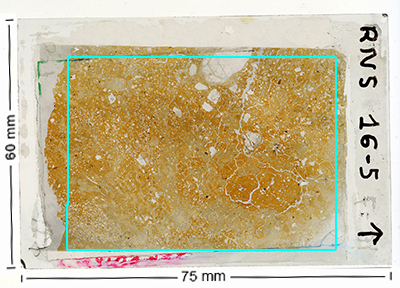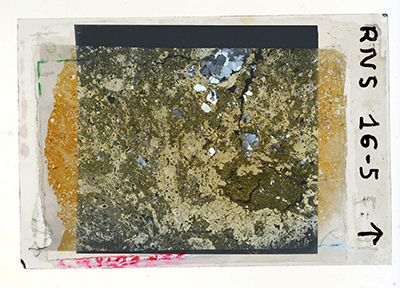 |
 |
|||||
Low/medium magnifications |
Low/medium magnifications |
A complex genetic problem.
2BCtk Horizon is a Calcic Palexeral decapitate.
Thin section RNS16-5. This preparation corresponds to the horizon inmedaitley below the horizon RNS16-4.
Horizon interpretation
I suggest to first browse, observe, describe and then, deduce from these images. I already did it and this is my interpretation.
The FACTS.
OTHER FACTS
The sand/silt areas show micromorphological features identic to the ones showed in the horizon below (hor 2CBtk)
The general characteristics describe the soil situated in a fluvial terrace.
According to the analytical data in the table, it is remarkable the high number of gravels in the two most superficial horizons whilst they rarely appear in the lower packet.
Micromorphologically speaking, horizon Bt1 is completely different to 2Bt2.
CONCLUSIONS
It is difficult to find carbonates in the horizon inmediately below, and the existing ones present coatings so that we can conclude they have an illuvial origin. There are no carbonates in the deepest packet (2CBt1 al 2CBt5), thus, we can conclude that the carbonates were not present in the sand and silt that create this palaeosoil .
All the previously mentioned statements lead into the following genesis.
The soil is composed of two packets with different origins. Horizons 2Bt2, 2Bt3, 2BCtk and 2CBtk belong to the lower packet. This soil is the preterrace (before terrace) that existed before the area was taken by the waters of the river Tormes. When the path of the river Tormes arrived, it dragged the upper horizons of the soil (Ah, E and the upper part 2Bt2 we can see now) and at the same time the waters deposit detritic material in its riverbed (upper packet). Later, when the waters of the river Tormes change its path, the abandone riverbed soil forming start and the upper horizons A and Bt1 are formed. Carbonates arrive with the waters and illuviate, accummulating in the lower horizons sealing the yellow primitive illuviation. Additionally, the new environment of the soil can be more aerated and the higher degree of oxidantion makes that the clay illuviating now in the new soil has more reddish colors.
When the lower horizons are buried by the packet upper to its terminology, we have to add a "b": 2Bt2b, 2Bt3b, 2BCtkb y 2CBtkb.
An ilustrative diagram of this geneis can be also found in another soil of the same terraces in section "Escrito en el suelo", specifically in this web site
The thin section RNS16-4 also belongs to this soil.
Soil data
Morphology, physical and chemical analysis
Micromorphologic images: Hor Ap Hor Bt1 Hor 2Bt2 Hor 2Bt3 Hor 2BCtk Hor 2CBtk comparative study
______________
This soil was presented in XIII Reunión Nacional de Suelos in Salamanca in 1985